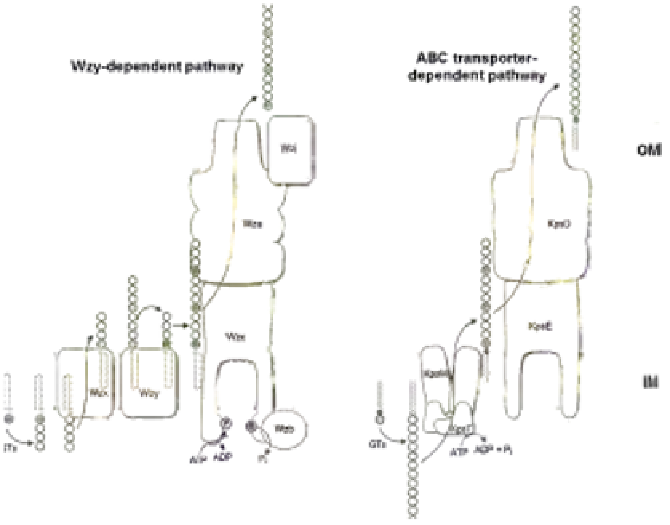Biology Reference
In-Depth Information
FIGURE 17.4
Biosynthesis of capsule. IM and OM are the inner and outer membranes respec-
tively. Capsular polysaccharides can by synthesized by either the Wzy- or ABC transporter-
dependent pathway.
belongs to sub-family 1 and its action appears to be confined to regulating the
polymerization activity, although the exact mechanism is still unknown. PCP-2a
proteins are more complex. Wzc certainly affects polymerization but this activ-
ity (and capsule formation) is dependent on the activity of a C-terminal tyrosine
autokinase domain, as well as the dephosphorylation of these residues by the
Wzb phosphatase (
Wugeditsch et al., 2001
). The autokinase domain is absent
in PCP-1 family members. The additional role played by Wzc is mediated by its
periplasmic domain, which is larger in PCP-2a proteins, and interacts with the
extensive periplasmic region of Wza (
Collins et al., 2007
). The crystal structure
of Wza reveals an octomer which forms a large periplasmic barrel connected to
an outer membrane channel (
Dong et al., 2006
). The outer-membrane pore is
formed by one α-helix contributed by each protamer and was the first example of
an outer-membrane channel which is not a β-barrel (
Dong et al., 2006
). It is not
known how the Wzc/Wza complex transports the capsule to the outer membrane
or what the nature of the reducing end of the exported polymer is; i.e. is the CPS
attached to an anchoring protein or lipid. In O-antigen biosynthesis, the ligase
(WaaL) releases the nascent glycan from the undecaprenyl pyrophosphate carrier
and links it to lipid A-core. There is no corresponding activity in the biosynthesis
of group 1 and 4 K antigens. The CPS could retain its linkage to undecaprenyl


Search WWH ::

Custom Search